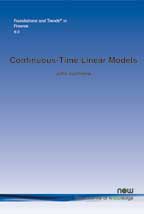Continuous-Time Linear Models
By John H. Cochrane, University of Chicago Booth School of Business and NBER, USA, john.cochrane@chicagobooth.edu
Abstract
I translate familiar concepts of discrete-time time series to contnuoustime equivalent. I cover lag operators, ARMA models, the relation between levels and differences, integration and cointegration, and the Hansen–Sargent prediction formulas.
Continuous-Time Linear Models
Discrete-time linear ARMA processes and lag operator notation are convenient for lots of calculations. Continuous-time representations often simplify economic models, and can handle interesting nonlinearities as well. But standard treatments of continuous-time processes typically don't mention how to adapt the discrete-time linear model concepts and lag operator methods to continuous time. Continuous-Time Linear Models attempts that translation and exposits the techniques to make the translation from familiar discrete-time ideas. The concluding section of this monograph collects the important formulas in one place. The author assumes a basic knowledge of discrete-time time-series representation methods and continuous-time representations.
